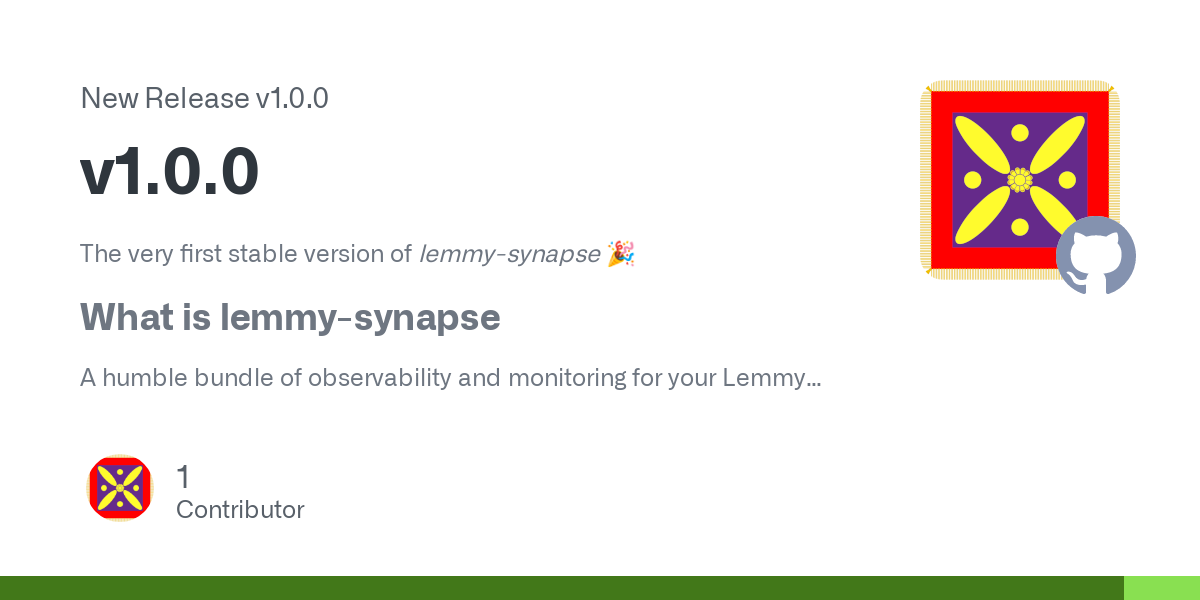bahmanm
Husband, father, kabab lover, history buff, chess fan and software engineer. Believes creating software must resemble art: intuitive creation and joyful discovery.
Views are my own.
- 50 Posts
- 181 Comments

 3·9 months ago
3·9 months agoUpdate
sh.itjust.works in now added to lemmy-meter 🥳 Thanks all.
I didn’t like the capitalised names so configured xdg to use all lowercase letters. That’s why
~/optfits in pretty nicely.You’ve got a point re
~/.local/optbut I personally like the idea of having the important bits right in my home dir. Here’s my layout (which I’m quite used to now after all these years):$ ls ~ bin desktop doc downloads mnt music opt pictures public src templates tmp videos workspacewhere
binis just a bunch of symlinks to frequently used apps fromoptsrcis where i keep clones of repos (but I don’t do work insrc)workspaceis a where I do my work on git worktrees (based offsrc)

 151·9 months ago
151·9 months agoThanks! So much for my reading skills/attention span 😂

 66·9 months ago
66·9 months agoWhich Debian version is it based on?
RE Go: Others have already mentioned the right way, thought I’d personally prefer
~/opt/goover what was suggested.
RE Perl: To instruct Perl to install to another directory, for example to
~/opt/perl5, put the following lines somewhere in your bash init files.export PERL5LIB="$HOME/opt/perl5/lib/perl5${PERL5LIB:+:${PERL5LIB}}" export PERL_LOCAL_LIB_ROOT="$HOME/opt/perl5${PERL_LOCAL_LIB_ROOT:+:${PERL_LOCAL_LIB_ROOT}}" export PERL_MB_OPT="--install_base \"$HOME/opt/perl5\"" export PERL_MM_OPT="INSTALL_BASE=$HOME/opt/perl5" export PATH="$HOME/opt/perl5/bin${PATH:+:${PATH}}"Though you need to re-install the Perl packages you had previously installed.

 3·9 months ago
3·9 months agoFirst off, I was ready to close the tab at the slightest suggestion of using Velocity as a metric. That didn’t happen 🙂
I like the idea that metrics should be contained and sustainable. Though I don’t agree w/ the suggested metrics.
In general, it seems they are all designed around the process and not the product. In particular, there’s no mention of the “value unlocked” in each sprint: it’s an important one for an Agile team as it holds Product accountable to understanding of what is the $$$ value of the team’s effort.
The suggested set, to my mind, is formed around the idea of a feature factory line and its efficiency (assuming it is measurable.) It leaves out the “meaning” of what the team achieve w/ that efficiency.
My 2 cents.
Good read nonetheless 👍 Got me thinking about this intriguing topic after a few years.

 1·9 months ago
1·9 months agoThis is fantastic! 👏
I use Perl one-liners for record and text processing a lot and this will be definitely something I will keep coming back to - I’ve already learned a trick from “Context Matching” (9) 🙂

 1·9 months ago
1·9 months agoThat sounds a great starting point!
🗣Thinking out loud here…
Say, if a crate implements the
AutomatedContentFlaggerinterface it would show up on the admin page as an “Automated Filter” and the admin could dis/enable it on demand. That way we can have more filters than CSAM using the same interface.
 2·9 months ago
2·9 months agoI couldn’t agree more 😂
Except that, what the author uses is pretty much standard in the Go ecosystem, which is, yes, a shame.
To my knowledge, the only framework which does it quite seamlessly is Spring Boot which, w/ sane and well thought out defaults, gets the tracing done w/o the programmer writing a single line of code to do tracing-related tasks.
That said, even Spring’s solution is pretty heavy-weight compared to what comes OOTB w/ BEAM.
 1·9 months ago
1·9 months agoI got to admit that your point about the presentation skills of the author are all correct! Perhaps the reason that I was able to relate to the material and ignore those flaws was that it’s a topic that I’ve been actively struggling w/ in the past few years 😅
That said, I’m still happy that this wasn’t a YouTube video or we’d be having this conversation in the comments section (if ever!) 😂
To your point and @krnpnk@feddit.de’s RE embedded systems:
That’s absolutely true that such a mindset is probably not going to work in an embedded environment. The author, w/o explicitly mentioning it anywhere, is explicitly talking about distributed systems where you’ve got plenty of resources, stable network connectivity and a log/trace ingestion solution (like Sumo or Datadog) alongside your setup.
That’s indeed an expensive setup, esp for embedded software.
The narrow scope and the stylistic problem aside, I believe the author’s view is correct, if a bit radical.
One of major pain points of troubleshooting distributed systems is sifting through the logs produced by different services and teams w/ different takes of what are the important bits of information in a log message.It get extremely hairy when you’ve got a non-linear lifeline for a request (ie branches of execution.) And even worse when you need to keep your logs free of any type of information which could potentially identify a customer.
The article and the conversation here got me thinking that may be a combo of tracing and structured logging can help simplify investigations.
 2·9 months ago
2·9 months agoThanks for sharing your insights.
Thinking out loud here…
In my experience with traditional logging and distributed systems, timestamps and request IDs do store the information required to partially reconstruct a timeline:
- In the case of a linear (single branch) timeline you can always “query” by a request ID and order by the timestamps and that’s pretty much what tracing will do too.
- Things, however, get complicated when you’ve a timeline w/ multiple branches.
For example, consider the following relatively simple diagram.
Reconstructing the causality and join/fork relations between the executions nodes is almost impossible using traditional logs whereas a tracing solution will turn this into a nice visual w/ all the spans and sub-spans.

That said, logs do shine when things go wrong; when you start your investigation by using a stacktrace in the logs as a clue. That (stacktrace) is something that I’m not sure a tracing solution will be able to provide.
they should complement each other
Yes! You nailed it 💯
Logs are indispensable for troubleshooting (and potentially nothing else) while tracers are great for, well, tracing the data/request throughout the system and analyse the mutations.
 2·9 months ago
2·9 months agoI’m not sure how this got cross-posted! I most certainly didn’t do it 🤷♂️
That was my case until I discovered that GNU tar has got a pretty decent online manual - it’s way better written than the manpage. I rarely forget the options nowadays even though I dont’ use
tarthat frequently.

 1·10 months ago
1·10 months agoI cross-posted the same questions on Matrix and got the answer there.
The hook I’m using is invoked before the minor modes are setup - that’s why it’s being overridden. The suggestion was to have a hook function for each minor mode that I want to control. It’s not clean but gets the job done.
Here’s the working snippet:
;;;;;;;;;;;;;;;;;;;;;;;;;;;;;;;;;;;;;;;;;;;;;;;;;;;;;;;;;;;;;;;;;;;;;;;;;;;;;;;;;; (defun bahman/helm-major-mode.hook () (display-line-numbers-mode -1) (puni-mode -1)) (add-hook 'helm-major-mode-hook #'bahman/helm-major-mode.hook) ;;;;;;;;;;;;;;;;;;;;;;;;;;;;;;;;;;;;;;;;;;;;;;;;;;;;;;;;;;;;;;;;;;;;;;;;;;;;;;;;;; (defvar bahman/display-line-numbers-mode.disabled-modes '(vterm-mode erlang-shell-mode) "Disable `display-line-numbers' for the specified modes.") (defun bahman/display-line-numbers-mode.hook () (when (seq-contains-p bahman/display-line-numbers-mode.disabled-modes major-mode) (display-line-numbers-mode -1))) (add-hook 'display-line-numbers-mode-hook #'bahman/display-line-numbers-mode.hook) ;;;;;;;;;;;;;;;;;;;;;;;;;;;;;;;;;;;;;;;;;;;;;;;;;;;;;;;;;;;;;;;;;;;;;;;;;;;;;;;;;; (defvar bahman/puni-mode.disabled-modes '(vterm-mode) "Disable `puni-mode' for the specificied modes.") (defun bahman/puni-mode.hook () (when (seq-contains-p bahman/puni-mode.disabled-modes major-mode) (puni-mode -1))) (add-hook 'puni-mode-hook #'bahman/puni-mode.hook)

 231·10 months ago
231·10 months agoThis is quite intriguing. But DHH has left so many details out (at least in that post) as pointed out by @breadsmasher@lemmy.world - it makes it difficult to relate to.
On the other hand, like DHH said, one’s mileage may vary: it’s, in many ways, a case-by-case analysis that companies should do.
I know many businesses shrink the OPs team and hire less experienced OPs people to save $$$. But just to forward those saved $$$ to cloud providers. I can only assume DDH’s team is comprised of a bunch of experienced well-payed OPs people who can pull such feats off.
Nonetheless, looking forward to, hopefully, a follow up post that lays out some more details. Pray share if you come across it 🙏
 2·10 months ago
2·10 months agoI think I understand where RMS was coming from RE “recursive variables”. As I wrote in my blog:
Recursive variables are quite powerful as they introduce a pinch of imperative programming into the otherwise totally declarative nature of a Makefile.
They extend the capabilities of Make quite substantially. But like any other powerful tool, one needs to use them sparsely and responsibly or end up w/ a complex and hard to debug Makefile.
In my experience, most of the times I can avoid using recursive variables and instead lay out the rules and prerequisites in a way that does the same. However, occasionally, I’d have to resort to them and I’m thankful that RMS didn’t win and they exist in GNU Make today 😅 IMO purist solutions have a tendency to turn out impractical.
 1·10 months ago
1·10 months agoUh, I’m not sure I understand what you mean.

 4·10 months ago
4·10 months agoTBH I use whatever build tool is the better fit for the job, be it Gradle, SBT or Rebar.
But for some (presumably subjective) reason, I like GNU Make quite a lot. And whenever I get the chance I use it - esp since it’s somehow ubiquitous nowadays w/ all the Linux containers/VMs everywhere and Homebrew on Mac machines.

 1·10 months ago
1·10 months agoLove the attitude 💪 Let me know if you need help in your quest.








“Announcment”
It used to be quite common on mailing lists to categorise/tag threads by using subject prefixes such as “ANN”, “HELP”, “BUG” and “RESOLVED”.
It’s just an old habit but I feel my messages/posts lack some clarity if I don’t do it 😅